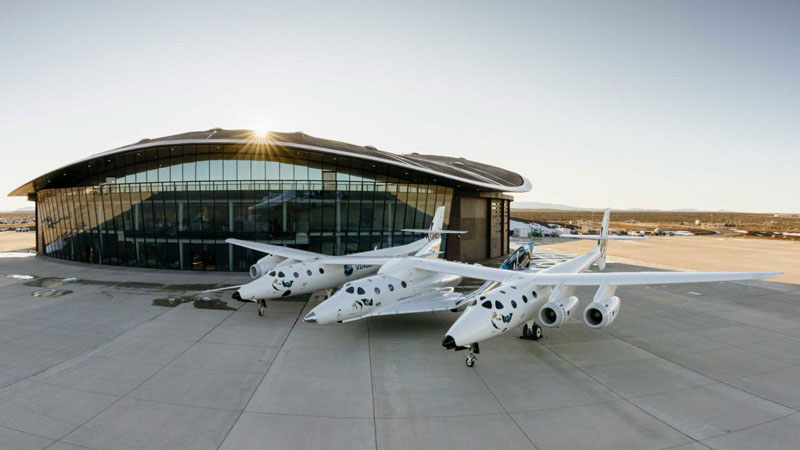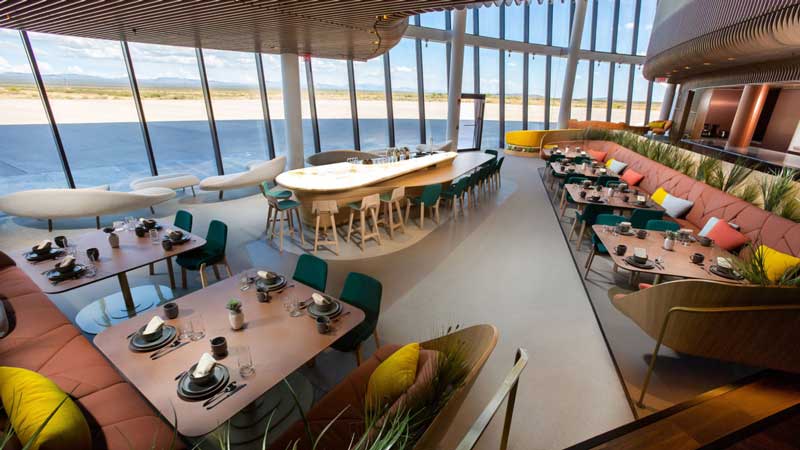Virgin Spaceport America and SpaceShipTwo Ready for Launch
The race to be the first company to carry commercial passengers into space is certainly hotting up. For many years, it has looked like a three horse race, with Elon Musk’s SpaceX, Jeff Bezos’s Blue Origin and our own Sir Richard Branson’s Virgin Galactic jockeying for position.
All have looked to be leading at various points in the battle. SpaceX must surely be regarded as the front runner – they are the only private company to have actually launched humans into space. This happened on Saturday 30th May 2020 as their Dragon spacecraft carried two NASA astronauts to the International Space Station (ISS), before safely returning to Earth on Sunday August 2nd.
However, this ground-breaking achievement was sponsored entirely by NASA, so it cannot be regarded as a commercial flight. And it seems as if SpaceX has other priorities. A further NASA sponsored mission to the ISS is due in the autumn, and Elon Musk seems more pre-occupied with lunar landings and missions to Mars than simply putting ticket buying passengers into low-Earth orbit.
Jeff Bezos has been quiet too, although to be fair, he is comparatively less keen on media self-promotion than his two rivals.
So maybe it will be Sir Richard who will steal the glory. He has certainly been hogging the headlines, with press releases and promised launches galore in recent weeks. The most eye-catching of these was the announcement in August that he himself will be joining fellow passengers on the inaugural Virgin Galactic spaceflight early in 2021. Two test flights were planned for the autumn of 2020 in advance of this first official commercial flight.
Of course, as ever with Mr Branson, all announcements do tend to be received with more than a little scepticism. He has a warranted reputation for his fondness for media stunts, although it does seem likely that he at least believes his own publicity. The fact remains though, that he has announced the imminent arrival of his first commercial space flight several times before, and it has yet to appear.
Nevertheless, it does seem likely that he is getting closer. Yes really. What is it that can provide us with the confidence that this really could be the one? Well, there are several factors at play.
Virgin Galactic Spaceport America
The completion of the stunning Virgin Galactic Spaceport America is a notable achievement. Located on a massive 27 square mile area of New Mexico desert, this is the place from which all future commercial launches are planned to take off.
It certainly looks spectacular, with the cutting edge architectural design of the passenger terminal more than fitting for the world’s first ever purpose built commercial spaceport. The magnificently curved building consists of three stories, with glass covering the entire front of the building to provide an excellent view of the surrounding desert and launch site.
The ground floor is taken up by the departure lounge and other practical aspects of the flight. It is unlikely that passengers will need (or indeed be permitted) to pack much luggage for the short flights, so the need for baggage control will be limited.
On the first floor is a social space, with a coffee bar and other facilities such as meeting places and viewing galleries. This area is perfect for members of the spaceflight crew, passengers and their friends and families to meet pre-flight and for the post flight debrief. The second floor is ‘mission control’, the centre for spaceflight operations. It will also house pilot accommodation and other crew facilities.
The massive building will also contain the hangar which will house the spaceplanes. This gives a fine indication of the scale of the construction. The hangar which, after all, is just a small part of the whole building, is huge. But then it has to be: it is large enough to house two White Knight Two launch vehicles, which each carry a wingspan of around 140 feet (43m), plus five of the SpaceShipTwo passenger-carrying spaceplanes.
The building will also serve as a training location for pilots and astronauts, as well as being able to provide facilities for any necessary training and guidance for future passengers.
Of course, none of this is evidence for spaceflights actually taking place. But it does provide clear proof of Virgin Galactic’s commitment to deliver very soon. Furthermore, the financial investment required to bring all these efforts to fruition is astounding. We can therefore be sure that Sir Richard will be keen to bring in some revenue from his fare paying passengers as soon as is practically possible.
The inside of Virgin’s Spaceport America
Virgin SpaceShipTwo Ready for Launch
July 2020 saw Virgin Galactic release spectacular footage of the interior of its passenger carrying spaceplane SpaceShipTwo. Again, sceptics will point to the renowned Branson talent for the media splash. Indeed, the press release itself warns that the specifications and descriptions promised are subject to change: “Prospective passengers are cautioned not to put undue reliance on forward-looking statements… [which] could cause the Company’s actual events and results to differ materially from those contained in the forward-looking statements.
But be in no doubt that even if everything does not turn out to be quite as suggested in the brochure, the new cabin does indeed look spectacular. Its design shows that the company have tried to think of everything in order to provide its passengers with the most enthralling, enveloping experience possible. The cabin architecture is specifically designed so that all its passenger astronauts can enjoy their period of weightlessness with as much freedom to move around as possible.
Clearly, from a safety point of view, passengers will need to be strapped in their luxury reclining seats during both launch and for the return flight. In order to maximise both safety and the overall passenger experience, a pilot-controlled recline mechanism will optimally position the astronauts’ seats to manage G- forces on both the boost and re-entry sections of the flight. Yet during the weightless phase between these periods, passengers will be able to float freely in an unrestricted zone within the spaceplane cabin.
The cabin itself has twelve ‘porthole’ style windows, offering all passengers a spectacular view of the blackness of space and the blue orb of the Earth beneath. During the weightless phase, passengers will be free to move around the cabin to find the best view. Each ‘window’ is designed with a soft, cushioned ‘halo’. This will enable astronauts to manoeuvre themselves around the cabin in zero gravity and position themselves to get the optimum view of planet Earth and the blackness of space above.
What’s more, sixteen cameras, some even mounted externally, will provide further footage. This will be available for passengers to select and view on high definition screens on all passenger seat backs. These monitors will also be able to display digital flight data direct from the flight deck. Even better, the on board cameras will also document the flight inside the cabin, so passengers will return to Earth with high definition officially recorded footage of their experience.
There will be no economy style bucket seats crammed onto these flights. Every seat will be customised for each individual passenger astronaut. This will apply to both seats and space suits, which will be individually designed for the ultimate in safety, security and comfort.
And, in the era of the selfie, what could be better than a giant sized mirror covering the entire rear cabin bulkhead to enable you to watch and take snaps of yourself and your surroundings as you enjoy your flight. Who knows, it may even be possible to live stream your journey on social media?
Time to Book a Flight?
Mmmm… maybe not quite yet. Not unless you’ve got a few hundred thousand pounds to spare. The original tranche of tickets were on sale for $200,000, with up to a thousand future astronauts already signed up. But the price has already increased to $250,000 for the next round of ticket sales, so you’d better get saving.
In the longer term, it is likely that prices will come down. There are two reasons for this. Firstly, the more people who actually do fly into space, the more planes can be built, so the price per passenger will fall. Imagine what a Spaceport America full of intrepid passengers will mean for economies of scale… What currently appears to be a futuristic fantasy will begin to make the spaceport look more like one of today’s international airport departure lounges.
Secondly, it is inconceivable that Virgin Galactic will be the only company offering to fly commercial passengers into space. Competition always drives down prices, so expect things to be more affordable soon. Maybe by the end of the decade, thousands or even millions of people will be able to afford to save for that unforgettable ‘once in a lifetime’ experience.


